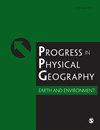阶梯池型自然鱼道水力设计准则的实验与数值研究
IF 3.6
3区 地球科学
Q2 GEOGRAPHY, PHYSICAL
Progress in Physical Geography-Earth and Environment
Pub Date : 2023-07-07
DOI:10.1177/03091333231187619
引用次数: 0
摘要
设计阶梯池类自然鱼道(NLFs)的水力考虑仅限于目标物种的身体尺寸。水流深度、池深、流速和湍流动能(堰口宽度和流量)的最大值等附加水力标准可以帮助设计最佳的阶梯池NLF。本研究利用计算流体动力学软件FLOW-3D®HYDRO建立了基于数值建模的设计图表和评级曲线。在1:4比例的阶梯池自然鱼道物理模型上的瞬时速度测量已被用于验证数值模型,该模型是根据现有的设计准则设计的。通过原型尺度上的数值模拟,分析了鱼道的水动力学特性与堰开比b r(0.10、0.25、0.45、0.65和1.00)和流量Q (0.1 ~ 1.5 m3/s)的关系。模拟结果表明,在b r = 0.10和0.25时,最大流速和平均流速明显低于b r > 0.25时。试验放电范围内的最大湍流动能和能量耗散因子均在推荐范围内(b r = 0.10和0.25)。目前的研究结果在设计图表和评级曲线方面说明了不同变量之间的关系,可以用于优化设计和易于现场实施。此外,本研究中提出的阶梯池NLF的床层结构可用于重建全尺寸或中试模型。本文章由计算机程序翻译,如有差异,请以英文原文为准。
Experimental and numerical investigation on the hydraulic design criteria for a step-pool nature-like fishway
Hydraulic considerations specific for the design of step-pool nature-like fishways (NLFs) are limited to the body dimensions of the target species. Additional hydraulic criteria for flow depth, maximum values for each of pool depth, velocity, and turbulent kinetic energy in terms of the weir opening width and discharge can help design an optimum step-pool NLF. The present study developed design charts and rating curves based on numerical modeling using the computational fluid dynamics software FLOW-3D® HYDRO. Instantaneous velocity measurements on a 1:4 scaled physical model of a step-pool nature-like fishway designed as per the available design guidelines have been used to validate the numerical model. The hydrodynamics of the fishway with respect to the weir opening ratio b r (0.10, 0.25, 0.45, 0.65, and 1.00) and discharge Q (0.1–1.5 m3/s) was analyzed through numerical simulations on a prototype scale. The simulation results showed that the maximum flow velocity and the averaged velocity over the crest at b r = 0.10 and 0.25 are considerably lower than at b r > 0.25. The maximum turbulent kinetic energy and energy dissipation factors for the tested range of discharges were within recommended limits for b r = 0.10 and 0.25. The present study outcome in terms of the design charts and rating curves that illustrate the relationship between different variables can be used for an optimum design and ease in field implementation. In addition, the bed structure of the step-pool NLF presented in this study can be used to recreate full-scale or pilot models.
求助全文
通过发布文献求助,成功后即可免费获取论文全文。
去求助
来源期刊
CiteScore
7.20
自引率
5.10%
发文量
53
审稿时长
>12 weeks
期刊介绍:
Progress in Physical Geography is a peer-reviewed, international journal, encompassing an interdisciplinary approach incorporating the latest developments and debates within Physical Geography and interrelated fields across the Earth, Biological and Ecological System Sciences.

 求助内容:
求助内容: 应助结果提醒方式:
应助结果提醒方式:


